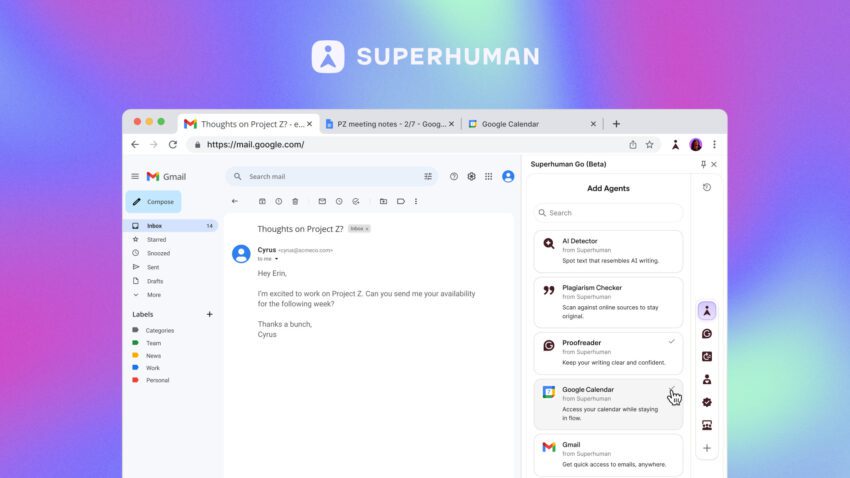
grammarly is changing its name to superhuman Grammarly has officially rebranded itself as Superhuman, marking a significant shift in its identity and operational focus.
grammarly is changing its name to superhuman
Overview of the Rebranding
AI writing aid Grammarly is now part of Superhuman, which also includes tools like Coda, Superhuman Mail, and a new AI assistant named Superhuman Go. This new suite of tools will be available starting today for all users with a paid Grammarly Pro subscription. Notably, Superhuman Go will be accessible to subscribers at no additional cost until February 1, 2026. However, Superhuman has not yet disclosed the pricing structure for the AI assistant beyond that date.
Background on the Transition
The rebranding to Superhuman is rooted in a series of strategic acquisitions. Grammarly adopted its new name from the AI email application Superhuman Mail, which it acquired in June 2024. This acquisition followed the earlier purchase of Coda, a collaborative workspace app, in December 2023. Together, these tools now operate under the Superhuman banner, reflecting a broader vision for productivity and collaboration in the digital workspace.
Visual Identity Changes
As part of this rebranding, even the Grammarly logo has been updated to align with the new identity of a productivity AI brand. This visual transformation signifies a departure from its original focus solely on writing assistance to a more comprehensive suite of productivity tools.
The Future of Grammarly
Despite the rebranding, the standalone writing tool Grammarly will continue to exist but will take a secondary role as Superhuman pivots its focus. The company aims to provide an AI agent-powered work platform that integrates seamlessly across various browser tabs. This platform is designed to offer contextual suggestions based on user activity and data from connected applications.
Features of Superhuman Go
Superhuman Go, the new AI assistant, is a core component of this transition. The assistant is designed to enhance productivity by connecting to over 100 applications, allowing it to provide contextual help. For instance, it can schedule meetings based on the availability shown in a user’s Google Calendar or retrieve specific details for a pitch based on information stored in a database. This level of integration aims to streamline workflows and make everyday tasks more manageable.
User Interface Familiarity
The user interface of Superhuman Go will feel familiar to existing Grammarly users. It features a sidebar for viewing suggestions, typing prompts, and accessing various AI agents. Grammarly itself remains one of these agents, but the new Superhuman Agent Store will offer additional options tailored for specific tasks or applications, including Google Workspace and Microsoft Outlook. This expanded functionality aims to position Superhuman as a one-stop solution for productivity needs.
Strategic Shift in Focus
Superhuman is strategically pivoting from its previous emphasis on writing to leverage Grammarly’s connections with other applications and web browsers as its main selling point. This shift reflects a broader trend in the tech industry, where companies are increasingly integrating AI capabilities to enhance user experience and productivity.
Enhanced Capabilities of Superhuman Go
According to Noam Lovinsky, Chief Product Officer at Superhuman, the capabilities of Superhuman Go far exceed those of the original Grammarly Go product, which was primarily focused on writing tasks. “The tasks that Superhuman Go is capable of helping me with are just far, far greater and much broader than what the original Grammarly Go product was able to do because it was mainly focused on the writing use cases,” Lovinsky stated in an interview with The Verge. This expansion of capabilities indicates Superhuman’s ambition to redefine how users interact with AI in their daily workflows.
Implications for Users
The rebranding and the introduction of Superhuman Go signify a substantial evolution in how users will engage with the platform. For existing Grammarly users, the transition may require some adjustment, but it also presents new opportunities for enhanced productivity. The integration of various tools under the Superhuman umbrella aims to create a more cohesive and efficient user experience.
Potential Challenges
While the rebranding offers numerous advantages, it is not without challenges. Users accustomed to Grammarly’s original focus on writing may need time to adapt to the broader functionality of Superhuman Go. Additionally, the transition raises questions about the long-term viability of the standalone Grammarly tool. Will it continue to receive updates and support, or will it eventually be phased out in favor of the more comprehensive Superhuman platform?
Stakeholder Reactions
The rebranding has elicited mixed reactions from stakeholders. Some users express excitement about the new features and capabilities, while others voice concerns about the potential dilution of Grammarly’s core writing assistance functionality. Lovinsky acknowledges these concerns, stating, “It’s a really complicated and frankly scary thing. But the reality is, the Grammarly brand isn’t going anywhere.” This statement aims to reassure users that while the brand is evolving, its foundational principles remain intact.
Market Positioning
In a competitive landscape filled with productivity tools and AI-driven applications, Superhuman’s rebranding positions it to better compete with other platforms. By integrating writing assistance with broader productivity features, Superhuman aims to capture a larger share of the market. This strategic positioning aligns with the growing demand for tools that enhance collaboration and efficiency in remote and hybrid work environments.
Looking Ahead
As Superhuman embarks on this new chapter, the company is likely to continue refining its offerings based on user feedback and market trends. The integration of AI into productivity tools is still in its early stages, and Superhuman’s approach may serve as a model for other companies looking to innovate in this space.
Future Developments
While specific details about future developments remain unclear, the company’s commitment to enhancing user experience through AI-driven solutions is evident. As the landscape of productivity tools continues to evolve, Superhuman’s ability to adapt and innovate will be crucial for its long-term success.
Conclusion
The transition from Grammarly to Superhuman marks a significant evolution in the company’s identity and operational focus. By integrating various productivity tools under the Superhuman brand, the company aims to redefine how users interact with AI in their daily workflows. As the rebranding unfolds, it will be essential for Superhuman to balance innovation with user familiarity to ensure a smooth transition for its existing customer base.
Source: Original report
Was this helpful?
Last Modified: October 29, 2025 at 6:38 pm
3 views















